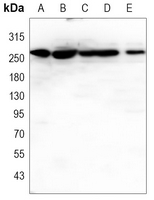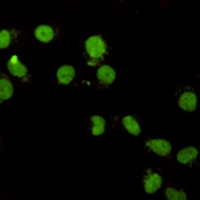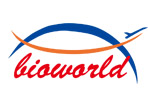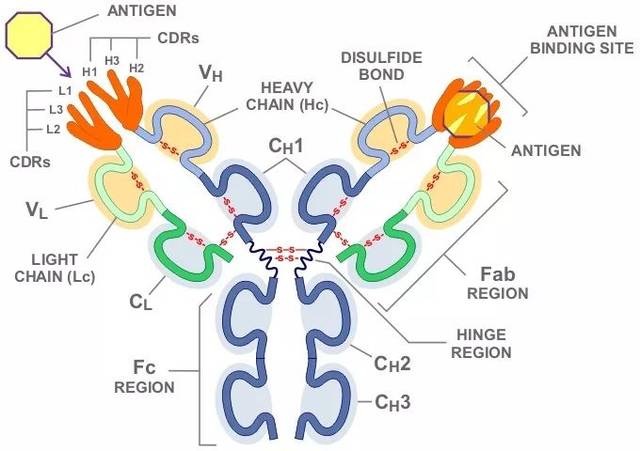Product Name :
CHD3 monoclonal antibody Background :
Chromodomain-helicase-DNA-binding domain (CHD) proteins have been identified in a variety of organisms. This family of nine proteins is divided into three separate subfamilies: subfamily I (CHD1 and CHD2), subfamily II (CHD3 and CHD4), and subfamily III (CHD5, CHD6, CHD7, CHD8, and CHD9). All CHD proteins contain two tandem amino-terminal chromodomains, a SWI/SNF-related ATPase domain, and a carboxy-terminal DNA-binding domain. The chromodomains facilitate binding to methylated lysine residues of histone proteins and confer interactions with specific regions of chromatin. The SWI/SNF-related ATPase domain utilizes energy from ATP hydrolysis to modify chromatin structure. CHD proteins are often found in large, multiprotein complexes with their transcriptional activation or repression activity governed by other proteins within the complex. CHD3 (also known as Mi2-α) and CHD4 (also known as Mi2-β) are central components of the nucleosome remodeling and histone deacetylase (NuRD) transcriptional repressor complex, which also contains HDAC1, HDAC2, RBAP48, RBAP46, MTA1, MTA2, MTA3, and MBD3 (3-8). Both CHD3 and CHD4 contain two plant homeodomain (PHD) zinc finger domains that bind directly to HDAC1 and HDAC2. Product :
Liquid in PBS containing 50% glycerol, 0.5% BSA and 0.02% sodium azide, pH 7.3. Storage&Stability :
Store at 4°C short term. Aliquot and store at -20°C long term. Avoid freeze-thaw cycles. Specificity :
Recognizes endogenous levels of CHD3 protein. Immunogen :
Purified recombinant human CHD3 (C-terminus) protein fragments expressed in E.coli. Conjugate :
Unconjugated Modification :
Unmodification
CHD3 monoclonal antibody Background :
Chromodomain-helicase-DNA-binding domain (CHD) proteins have been identified in a variety of organisms. This family of nine proteins is divided into three separate subfamilies: subfamily I (CHD1 and CHD2), subfamily II (CHD3 and CHD4), and subfamily III (CHD5, CHD6, CHD7, CHD8, and CHD9). All CHD proteins contain two tandem amino-terminal chromodomains, a SWI/SNF-related ATPase domain, and a carboxy-terminal DNA-binding domain. The chromodomains facilitate binding to methylated lysine residues of histone proteins and confer interactions with specific regions of chromatin. The SWI/SNF-related ATPase domain utilizes energy from ATP hydrolysis to modify chromatin structure. CHD proteins are often found in large, multiprotein complexes with their transcriptional activation or repression activity governed by other proteins within the complex. CHD3 (also known as Mi2-α) and CHD4 (also known as Mi2-β) are central components of the nucleosome remodeling and histone deacetylase (NuRD) transcriptional repressor complex, which also contains HDAC1, HDAC2, RBAP48, RBAP46, MTA1, MTA2, MTA3, and MBD3 (3-8). Both CHD3 and CHD4 contain two plant homeodomain (PHD) zinc finger domains that bind directly to HDAC1 and HDAC2. Product :
Liquid in PBS containing 50% glycerol, 0.5% BSA and 0.02% sodium azide, pH 7.3. Storage&Stability :
Store at 4°C short term. Aliquot and store at -20°C long term. Avoid freeze-thaw cycles. Specificity :
Recognizes endogenous levels of CHD3 protein. Immunogen :
Purified recombinant human CHD3 (C-terminus) protein fragments expressed in E.coli. Conjugate :
Unconjugated Modification :
Unmodification
-
 Western blot analysis of CHD3 expression in NTERA2 (A), NIH3T3 (B), C6 (C), K562 (D), Hela (E) whole cell lysates.
Western blot analysis of CHD3 expression in NTERA2 (A), NIH3T3 (B), C6 (C), K562 (D), Hela (E) whole cell lysates. -

Bioworld Biotech only provide peptides for our antibodies and do not provide additional peptide customization services.
Price/Size :
USD 368/1mg/vial
Tips:
For phospho antibody, we provide phospho peptide(0.5mg) and non-phospho peptide(0.5mg).Describe :
Blocking peptides are peptides that bind specifically to the target antibody and block antibody binding. These peptide usually contains the epitope recognized by the antibody. Antibodies bound to the blocking peptide no longer bind to the epitope on the target protein. This mechanism is useful when non-specific binding is an issue, for example, in Western blotting (WB) and Immunohistochemistry (IHC). By comparing the staining from the blocked antibody versus the antibody alone, one can see which staining is specific; Specific binding will be absent from the western blot or IHC performed with the neutralized antibody.Formula:
Synthetic peptide was lyophilized with 100% acetonitrile and is supplied as a powder. Reconstitute with 0.1 ml DI water for a final concentration of 10 mg/ml.The purity is >90%,tested by HPLC and MS.
Storage:
The freeze-dried powder is more stable. For short time at 2-8°C. For long term storage store at -20°C.
Note :
This product is for research use only (RUO only). Not for use in diagnostic or therapeutic procedures.
 CHD3 monoclonal antibody
CHD3 monoclonal antibody  Datasheet
Datasheet COA
COA MSDS
MSDS SHIP
SHIP